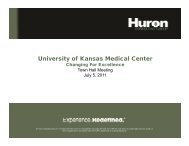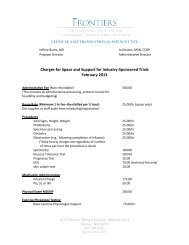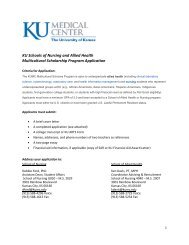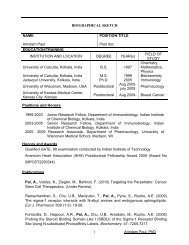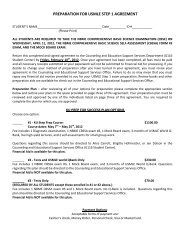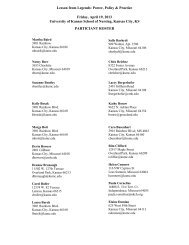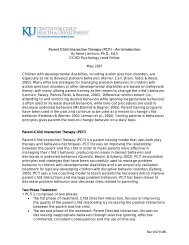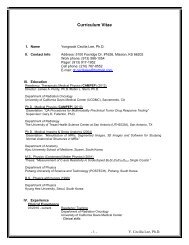Clinical Orientation Manual - University of Kansas Medical Center
Clinical Orientation Manual - University of Kansas Medical Center
Clinical Orientation Manual - University of Kansas Medical Center
Create successful ePaper yourself
Turn your PDF publications into a flip-book with our unique Google optimized e-Paper software.
CHART WORK<br />
Anything you enter into a patient’s chart has the potential to be used as a reference which may<br />
help to guide the patient’s future health management. It is also a legal document which may<br />
become public record if used in court. It is absolutely imperative that clinical clerks do not write<br />
anything in the chart which is not true or not actually observed by you personally. If you are going<br />
to include information which was observed by others (i.e. a physical finding noted in the residents<br />
notes, but not by you) you must include this as part <strong>of</strong> your note. It is also unacceptable to<br />
photocopy any portion <strong>of</strong> a patient’s record (including your History and Physicals once they are in<br />
the chart), as this is a breech in patient confidentiality. It is always a good idea to “ask before you<br />
do,” and this will come in handy throughout your career in medicine.<br />
HISTORY AND PHYSICAL<br />
Maxwell’s pocket manual is an extremely valuable resource for H & P’s, SOAP, pre & post-op<br />
notes, etc. We consider this a requirement for the third year!<br />
A topic not discussed elsewhere in the manual is the responsibility <strong>of</strong> presenting patients to<br />
residents and attendings. The verbal presentation <strong>of</strong> a patient proceeds in the same order as the<br />
admission H&P-CC, HPI, PMHx (including medications and allergies), PSHx, FHx, SHx, ROS,<br />
physical exam, labs, and finally, clinical impression and plan. The object <strong>of</strong> presenting a patient is<br />
to communicate enough pertinent information about the patient that someone who does not<br />
know the patient will be adequately informed and satisfied.<br />
An example <strong>of</strong> beginning a presentation: “Mr. Doe is a 45 year old white male with a history <strong>of</strong><br />
COPD, angina and an inferior MI in the past, who now presents with angina <strong>of</strong> increasing severity<br />
and duration.” The first statement <strong>of</strong> the presentation is the most important and by including the<br />
pertinent past history gives the attending and others present a brief synopsis <strong>of</strong> the patient’s<br />
status. In general, it is wise to present only the pertinent findings in the H&P — laboratory work,<br />
x-rays, EKG, etc. Nevertheless, the most important piece <strong>of</strong> your presentation is the assessment<br />
and plan for the patient. This is where the attending will be able to assess your clinical expertise.<br />
Attending physicians will vary in their expectations. It is always acceptable to ask residents or the<br />
attending how they expect patients to be presented. Observing and learning from others is also<br />
very helpful.<br />
S.O.A.P. NOTES<br />
Subjective:<br />
This part <strong>of</strong> the S.O.A.P. note should briefly describe how the patient feels and any complaints<br />
he/she might have. Analogous to the chief complaint portion <strong>of</strong> a History and Physical, it should<br />
be stated in the patient’s own words whenever possible. It should also contain, when pertinent,<br />
your own subjective observations about the patient, for example, his/her general mental state or<br />
appearance. This is also where you can include any pertinent nursing comments.<br />
Objective:<br />
This part <strong>of</strong> the S.O.A.P. note lists objective data including current vital signs, inputs/outputs,<br />
pertinent physical exam findings (which always includes cardiovascular, pulmonary and<br />
abdominal exam and only the other physical findings which are pertinent to that patient), and<br />
40



